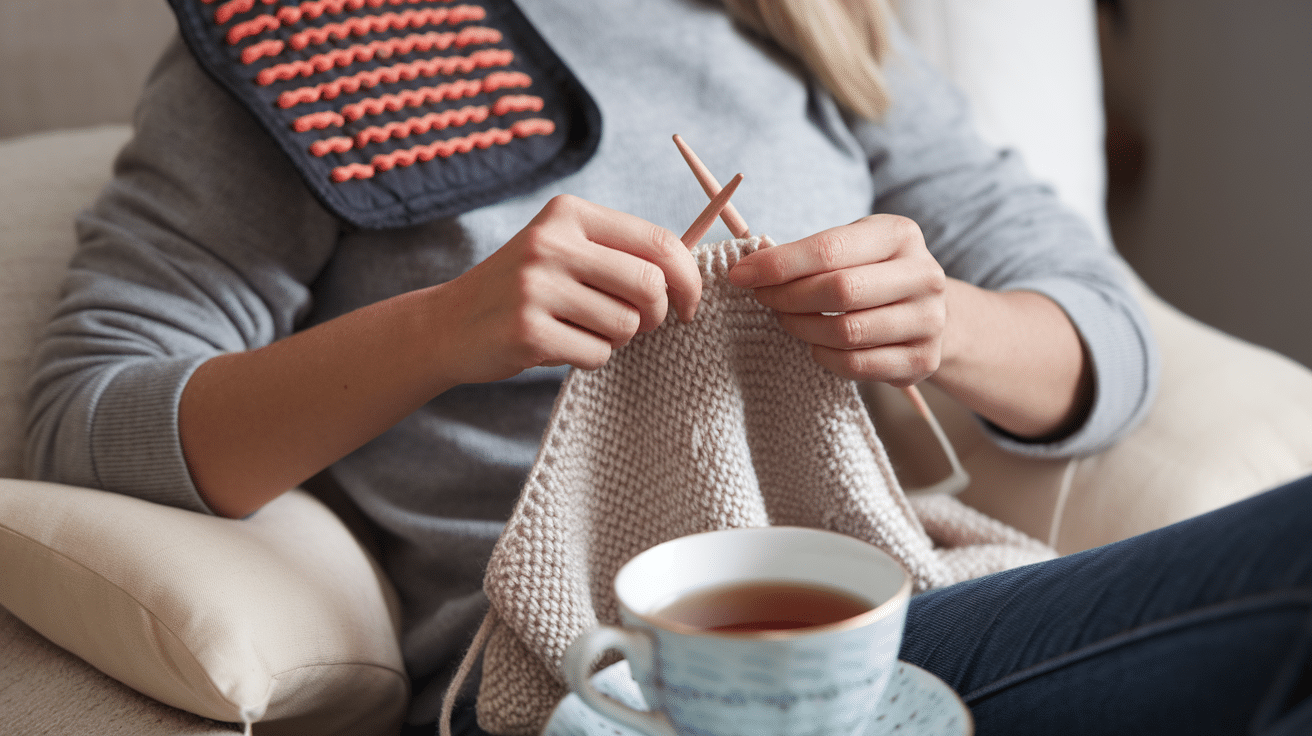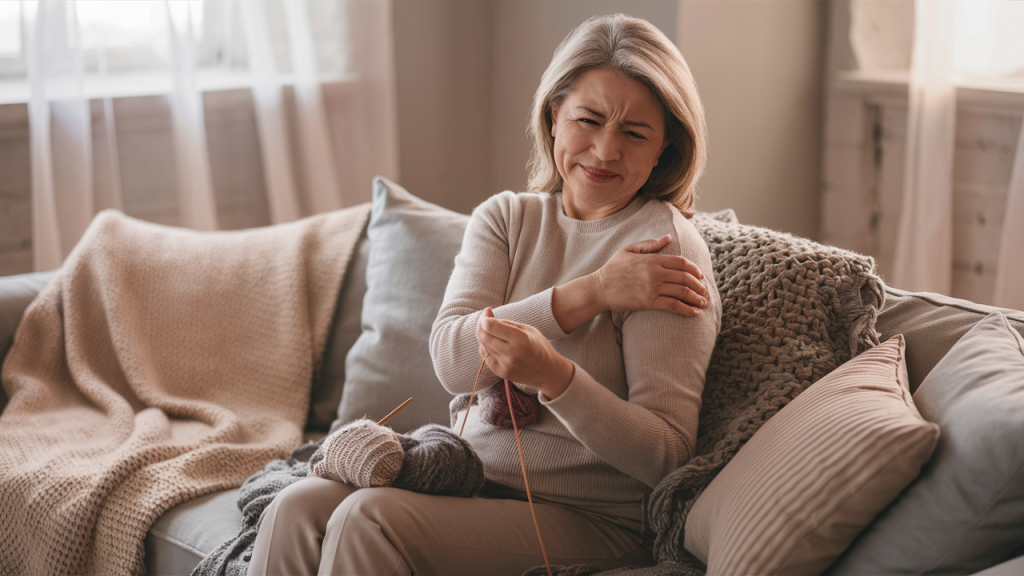Knitting is a relaxing hobby, but it can also cause shoulder pain. Sitting for long periods and using the same motions over and over can make your shoulders stiff and sore.
If you ignore the pain, it can get worse and make knitting less enjoyable. The good news is that small changes can help.
Simple things like sitting the right way, taking breaks, and stretching can make a big difference. You don’t have to give up knitting to feel better.
You can keep knitting without discomfort by learning what causes shoulder pain and how to fix it. This guide will cover everything you need to know about knitting shoulder pain, from common causes to helpful stretches and better knitting habits.
These simple tips will help you stay comfortable so you can enjoy your projects without pain slowing you down.
Causes of Shoulder Pain from Knitting

Shoulder pain from knitting is usually caused by repeated movements, poor posture, and muscle tension. The most common reasons are:
1. Poor Posture
Posture plays a major role in shoulder pain. Many knitters slouch or hunch over their work, placing extra strain on the neck, shoulders, and upper back. Poor posture can:
- Cause muscle imbalances that lead to stiffness and pain.
- Increase pressure on the spine and shoulders.
- Reduces circulation, making muscles fatigue faster.
How to Fix It:
- Sit with a straight back and shoulders relaxed.
- Keep your feet flat on the floor or on a small footrest.
- Make sure your head is aligned with your shoulders, not leaning forward.
2. Repetitive Movements
Knitting involves small, repeated motions of the hands, wrists, and arms. Over time, this repetitive stress can cause strain in the shoulder muscles. This can lead to:
- Fatigue in the shoulder and upper arm muscles.
- Tightness that spreads to the neck and upper back.
- Increased risk of tendonitis or inflammation.
How to Fix It:
- Take frequent breaks to let your muscles recover.
- Alternate between different knitting techniques.
- Avoid knitting for long periods without moving.
3. Holding Tension in the Shoulders
Some knitters unknowingly keep their shoulders raised or tight while knitting. This tension puts extra strain on the muscles, leading to pain and stiffness.
How to Fix It:
- Make sure your shoulders are relaxed while knitting.
- Do shoulder rolls before and after knitting.
- Shake out your arms every 20–30 minutes to release tension.
4. Knitting for Long Periods Without Breaks
Sitting still for too long can cause stiffness in the shoulders and back. The longer you stay in the same position, the harder it is for your muscles to recover.
How to Fix It:
- Stand up and stretch every 30–45 minutes.
- Set a timer to remind yourself to take breaks.
- Walk around or do light stretching between knitting sessions.
5. Heavy Yarn or Large Projects
Knitting large or heavy projects, such as blankets or sweaters, requires more effort from your arms and shoulders. Holding up the weight for long periods can cause soreness.
How to Fix It:
- Use circular needles to distribute weight evenly in your lap.
- Support large projects with a pillow or table.
- Take more breaks when working on heavy items.
6. Wrong Chair or Knitting Setup
Sitting in a chair without proper back support or working on a table that is too high or too low can put a strain on the shoulders and upper body.
How to Fix It:
- Use a chair with good lumbar support.
- Adjust your workspace to a comfortable height.
- Keep your elbows at a 90-degree angle while knitting.
Symptoms of Knitting-Related Shoulder Pain
Shoulder pain from knitting can vary in intensity. Some common symptoms to look out for:
- Dull or sharp pain in the shoulder area
- Stiffness in the neck and upper back
- Aching muscles after long knitting sessions
- Tingling or numbness in the arms or hands
- Weakness when lifting objects
- Pain that worsens after knitting for long periods
If you notice any of these symptoms, it’s important to take action before the pain gets worse.
When to See a Doctor
Most knitting-related shoulder pain can be managed with simple changes, but sometimes medical attention is needed. You should see a doctor if:
- The pain does not improve after rest and self-care.
- You feel tingling, numbness, or weakness in your arms or hands.
- Your shoulder pain worsens over time.
- You experience swelling or redness in the shoulder area.
- You have trouble moving your arm or shoulder.
If you experience any of these symptoms, a doctor can help determine if you have a more serious condition like tendonitis or a rotator cuff injury.
Potential Long-Term Issues from Knitting Shoulder Pain
Ignoring shoulder pain from knitting can lead to more serious muscle and joint problems – which can progress into more significant musculoskeletal issues if left unaddressed.
- Tendonitis or Bursitis: Inflammation from overuse, leading to pain and stiffness.
- Rotator Cuff Strain: Repetitive motion can strain or impinge shoulder muscles, affecting movement.
- Chronic Muscle Tension: Holding one position too long can create tight, painful knots in the shoulders and neck.
- Postural Problems: Hunching over can lead to rounded shoulders and long-term discomfort.
To prevent these problems, take breaks, stretch often, and maintain good posture. If pain worsens or doesn’t improve, seek medical advice.
Disclaimer: This content is for informational purposes only and should not replace professional medical advice. If you experience persistent or severe pain, consult a healthcare provider.
Treatment Options for Knitting Shoulder Pain

If you have shoulder pain from knitting, there are several ways to relieve discomfort and heal faster.
- Rest and Reduce Knitting Time: Give your shoulders time to recover by taking short breaks or reducing knitting time.
- Heat Therapy: A heating pad or warm towel can relax tight muscles and improve circulation.
- Ice Therapy: An ice pack wrapped in a towel can help reduce swelling and numb pain.
- Massage Therapy: A gentle shoulder massage can help relax tight muscles and improve blood flow.
- Pain Relief Creams or Patches: Topical creams with menthol or anti-inflammatory ingredients can provide temporary relief.
- Over-the-Counter Pain Medications: Non-prescription pain relievers like ibuprofen can help with inflammation.
- Gentle Stretches and Exercises: Regular stretching can prevent stiffness and promote healing.
The Best Stretches and Strengthening Exercises for Knitters

Stretching and strengthening exercises can help keep your muscles flexible and strong, preventing discomfort.
1. Shoulder Rolls (Relieves tension in the shoulders and upper back)
Steps:
- Sit or stand with your back straight.
- Relax your shoulders and let your arms rest at your sides.
- Slowly roll your shoulders forward in a circular motion.
- Complete 10 forward rolls.
- Repeat the same motion in the opposite direction, rolling backward for 10 reps.
Tip: Breathe deeply while doing this exercise to help release tension.
2. Neck Stretch (Eases tension in the neck and shoulders)
Steps:
- Sit up straight with shoulders relaxed.
- Slowly tilt your head to one side, bringing your ear closer to your shoulder.
- Hold this position for 15 seconds.
- Return to the center and repeat on the other side.
- Perform 3 sets on each side.
Variation: For a deeper stretch, gently place your hand on the side of your head and apply light pressure.
3. Cross-body shoulder Stretch (Improves flexibility in the shoulder muscles)
Steps:
- Extend your right arm straight across your chest.
- Use your left hand to pull your right arm closer to your body.
- Hold the stretch for 15–20 seconds.
- Switch arms and repeat.
- Perform 2–3 sets on each side.
Tip: Keep your shoulders down and relaxed while stretching.
4. Wall Angels (Strengthens shoulders and improves posture)
Steps:
- Stand with your back against a wall, feet a few inches away.
- Press your lower back and shoulders against the wall.
- Raise your arms into a “goalpost” position, with elbows bent at 90 degrees.
- Slowly raise your arms overhead, then lower them back down.
- Repeat for 10–12 reps.
Tip: Keep your core engaged and avoid arching your back.
5. Shoulder Blade Squeeze (Strengthens upper back muscles)
Steps:
- Sit or stand with your back straight.
- Squeeze your shoulder blades together as if holding a pencil between them.
- Hold for 5 seconds, then release.
- Repeat 10–12 times.
Tip: Avoid shrugging your shoulders up—keep them relaxed.
6. Resistance Band Shoulder Strengthening (Improves shoulder stability)
Steps:
- Hold a resistance band with both hands, palms facing up.
- Keep your elbows close to your sides.
- Gently pull the band apart, stretching it outward.
- Slowly return to the starting position.
- Repeat for 10–15 reps.
Variation: Perform this exercise with your arms extended for a different angle of resistance.
How Often Should You Stretch and Strengthen?
For best results, follow this routine:
- Stretching: Before and after knitting sessions, or at least 3–4 times a day if you experience tightness.
- Strengthening: 2–3 times per week to improve endurance and prevent pain.
Recovery Time for Knitting Shoulder Pain
The time it takes to recover from knitting-related shoulder pain depends on several factors, including the severity of the pain, how long the issue has been present, and the steps taken to relieve it.
Mild pain usually improves in a few days with rest, stretching, and posture changes. However, if the muscles are more inflamed or overworked, recovery may take one to two weeks.
For more severe pain, where movement is restricted, or discomfort persists even after rest, recovery can take several weeks.
In these cases, physical therapy, targeted exercises, and changes in knitting habits may be necessary. If the pain is caused by an underlying condition such as tendonitis or a rotator cuff strain, recovery could take longer and may require medical intervention.
During recovery, it’s important to listen to your body. Reducing knitting time, taking frequent breaks, and practicing proper posture can help speed up healing.
Applying heat or ice, using massage techniques, and doing gentle stretches can also ease tension and improve circulation. Strengthening exercises should be introduced gradually to prevent re-injury.
Disclaimer: If pain continues for more than two weeks despite these measures, it’s best to seek medical advice. A doctor or physical therapist can assess the problem and recommend additional treatments, such as specialized exercises or anti-inflammatory medications.
Conclusion
Knitting should be a fun and relaxing activity, not something that causes pain. Shoulder pain from knitting happens when muscles become stiff, overworked, or strained from poor posture and repetitive movements.
The good news is that simple changes can make a big difference. Paying attention to posture, taking regular breaks, and stretching can help prevent discomfort.
If pain does occur, there are many ways to ease it. Resting, using heat or ice, and doing gentle exercises can help muscles recover.
Strengthening the shoulders and upper back can also prevent future pain. Making small adjustments, like using ergonomic needles or resting your arms on a pillow, can keep knitting comfortable.
If pain continues despite rest and self-care, it’s best to see a doctor. Taking care of your shoulders now means you can enjoy knitting for years to come.
Frequently Asked Questions
Is shoulder pain from knitting more common in older adults?
While anyone can experience shoulder pain from knitting, older adults may be more prone to it due to reduced muscle strength, joint stiffness, and arthritis. Stretching, strength exercises, and using ergonomic tools can help reduce the risk.
Can certain knitting needles help reduce shoulder pain?
Yes, ergonomic knitting needles can help reduce strain on your hands and shoulders. Circular needles can also help distribute the weight of large projects, preventing extra pressure on your arms.
Are there specific chairs or cushions that can help prevent shoulder pain while knitting?
Using a chair with good lumbar support and armrests can improve posture and reduce strain. A small pillow under the arms or behind the lower back can also help maintain a comfortable position while knitting.









